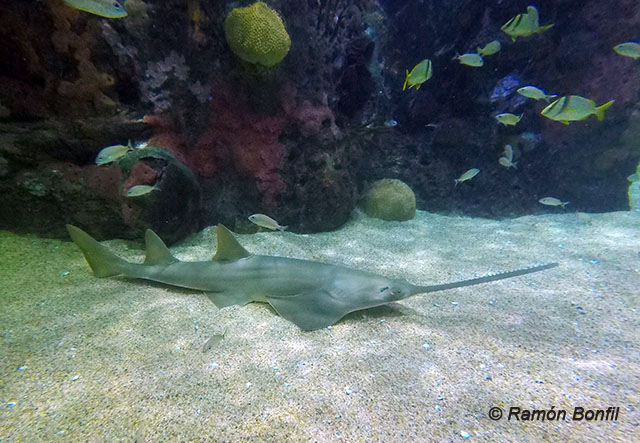| Pristidae (Sawfishes) |
| 760 cm TL (male/unsexed); max.weight: 350 kg |
|
demersal; freshwater; brackish; marine; depth range 10 - 88 m, amphidromous |
| Atlantic and South-West Indian Oceans; once widespread. |
|
Diagnosis: Pristis pectinata is easily separable from Pristis perotteti by the following characters: its first dorsal fin originates about over the origin of its pelvic fins vs. considerably in front of origin of pelvic fins in P. perotteti; its caudal fin is much shorter, but broader relative to the length of the fin, with lower lobe only faintly indicated; its rostral teeth are numerous, 23 or more on each side vs. not more than 20 in P. perotteti; its saw is relatively somewhat shorter; its second dorsal fin has the posterior margin much less deeply concave; and its pectoral fins are smaller (Ref. 6902, 81624). Pristis pectinata agrees with Pristis pristis in the shape of its caudal fin and in the position of the first dorsal fin relative to the pelvic fins, but it can be separated from P. pristis by its more numerous rostral teeth, 23 or more on each side vs. less than 20 (Ref. 6902, 81624).
Description: Long, flat, blade-like rostrum with at least 23 and up to 32 pairs of rostral spines along edges (Ref. 26938, 81624). First dorsal fin originating at same level as pelvic fin origin and base slightly longer than second dorsal fin (Ref. 81624). Caudal fin with a much larger and oblique dorsal lobe and without a clearly defined ventral lobe (Ref. 26938, 81624).
Colouration: Nearly uniform dark mouse gray to blackish brown above, paler along margins of fins; white to grayish white or pale yellow below (Ref. 6902, 81624). |
| Inshore and intertidal species, but may cross deep water to reach offshore islands; also ascends rivers and can tolerate fresh water (Ref. 9859). Commonly seen in bays, lagoons, estuaries, and river mouths. Also found in rivers and lakes (Ref. 12951). Feeds on fishes and shellfishes (Ref. 58784). Ovoviviparous (Ref. 50449). Gravid females reportedly carry as many as 20 embryos, which require a year of gestation (Ref. 27549). Uses its saw to stir the bottom when feeding on bottom invertebrates and to kill pelagic fishes (Ref. 9859). Utilized as a food fish; oil is used to make medicine, soap and in leather tanning (Ref. 6871). Adults stuffed for decoration (Ref. 6871). Reported to be aggressive towards sharks when kept in tanks (Ref. 12951). This species is currently protected in several areas as populations are under severe threat (Ref. 81624). |
|
Critically Endangered (CR); Date assessed: 09 March 2022 (A2cd) Ref. (130435)
|
| traumatogenic |
Source and more info: www.fishbase.org. For personal, classroom, and other internal use only. Not for publication.
